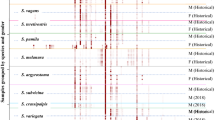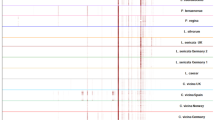Abstract
Gas Liquid Chromatography was used to obtain profiles of cuticular hydrocarbons from single larvae of two species belonging to the Anopheles gambiae complex: A. gambiae and A. arabiensis. By applying discriminant analysis of hydrocarbons it was possible to separate the two populations with a 95% success rate.
The same analysis was used to achieve an average of 94% segregation among their strains. This analysis does not require preservation of specimen by liquid nitrogen or refrigeration and further identification by other procedures can be carried out on the specimens after cuticular hydrocarbon analysis. More importantly the technique permits analysis of single rather than pooled specimens used by earlier investigators.
Résumé
Les profils de hydrocarbones de la cuticle des larves individuelles de deux espéces appartenant au complex Anopheles gambiae (A. gambiae et A. arabiensis) furent obtenus grâce á la chromatographic á phase gaseuse. En utilisant l’analyse du discriminant aux hydrocarbones il a étè possible de separer les deux populations avec un taux de succes de 95%. La même analyse a étè utilisé pour atteindre une moyenne de 94% de separation entre ces espéces. L’analyse ne necessite pas la preservation des specimen dans du nitrogene ou dans le frigidaire et d’autre procedures d’identification peuvent être effectuer après l’analyse des hydrocarbones. Plus important, la technique permet l’analyse d’un seul specimen au lieu de plusieurs comme precedament.
Similar content being viewed by others
References
Carlson D. A. and Service M. W. (1979) Differentiation between species of the Anopheles gambiae complex (Diptera: Culicidae) by analysis of cuticular hydrocarbons. Ann. trop. Med. Parasitol. 3, 589–592.
Carlson D. A. and Service M. W. (1980) Identification of mosquitoes of Anopheles gambiae species complex A and B by analysis of cuticular components. Science 207, 1089–1091.
Dixon W. J. (1988) Statistical Software Manual (1988 Software Release). University of California Press, Berkeley.
Hamilton R. J. and Service M. W. (1983) Value of cuticular and internal hydrocarbons for the identification of larvae of Anopheles gambiae Giles, Anopheles arabiensis Patton, and Anopheles melas Theobald. Ann. trop. Med. Parasitol 77, 203–210.
Howard R. M. and Blomquist G. J. (1982) Chemical ecology and biochemistry of insect hydrocarbons. Annu. Rev. Entomol. 27, 149–172.
Kendall M., Stuart A. and Ord J. K. (1983) The A dvanced Theory of Statistics, Volume 3. Design and Analysis, and Time Series. 4th edn. Charles Griffin, High Wycombe, Bucks.
Lockey K. H. (1976) Cuticular hydrocarbons of locusta: Schistocerca and Periplaneta and their role in waterproofing. Insect Biochem. 6, 457–472.
Lockey K. H. (1978) The adult cuticular hydrocarbons of Tenebrio molitor L and Tenebrio obscurus. (Coleoptera: Tenebrionidae). Insect Biochem. 8, 237–250.
Milligan P. J. M., Phillips A., Molyneux D. H., Subbarao S. K. and White G. B. (1986) Differentiation of Anopheles culicifacies Giles (Diptera: Culicidae) sibling species by analysis of cuticular components. Bull, entomol. Res. 76, 529–537.
Morrison D. F. (1976) Multivariate Statistical Methods. 2nd edn, New York, Wiley.
Phillips A., Walsh J. F., Garms R., Molyneux D. H., Milligan P. and Ibrahim G. H. (1985) Identification of adults of the Simulium damnosum complex using hydrocarbon analysis. Tropenmed. Parasitol. 36, 97–101.
Phillips A. and Milligan P. (1986) Cuticular hydrocarbons distinguish sibling species of vectors. Parasitology Today 2, 180–181.
Phillips A., Milligan P. J. M., Coluzzi M., Toure Y., Broomfield G. and Molyneux D. H. (1987) Studies of the chromosomal forms of Anopheles gambiae s.str. and Anopheles arabiensis using cuticular hydrocarbon analysis. Proceedings 3rd International Conference on Malaria and Babesiosis, 7–11th Sept. 1987, Annecy, France.
Phillips A., Milligan P. J. M., Broomfield G. and Molyneux D. H. (1988) Identification of medically important Diptera by analysis of cuticular hydrocarbons. In Biosystematics of Haematophagous Insects (Edited by Service M. W.), pp.39–59.Clarendon Press, Oxford (Systematic’s Association Special Volume No. 37).
Author information
Authors and Affiliations
Rights and permissions
About this article
Cite this article
Anyanwu, G.I., Phillips, A. & Molyneux, D.H. Variation in the Cuticular Hydrocarbons of Larvae of Anopheles Gambiae and A. Arabiensis. Int J Trop Insect Sci 15, 117–122 (1994). https://doi.org/10.1017/S1742758400015332
Received:
Accepted:
Published:
Issue Date:
DOI: https://doi.org/10.1017/S1742758400015332




